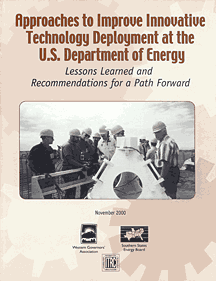|
State perspectives contained in report on innovative technology deploymentThe U.S. Department of Energy
needs to at least double its funding for deployment assistance activities
to maximize the number of innovative technologies that get used in
the cleanup process. That and more than 15 other recommendations were
made in a report issued in November 2000. The report, Approaches
to Improve Innovative Technology Deployment at the U.S. Department
of Energy: Lessons Learned and Recommendations for a Path Forward,
evolved as a result of three workshops held on the subject of technology
deployment within the Environmental
Management program at DOE. The workshops brought together state
and interstate groups, regulators, DOE site contractors, federal officials,
and stakeholder groups with the goal of facilitating dialogue about
the deployment process.
“This is the first comprehensive overview of EM’s past
programs,” notes project manager and contributing author, Michael
Jacobson, “and it draws on a number of different perspectives.
Due to this diverse participation, the report offers a broad spectrum
of recommendations for improving the deployment process. At the same
time, it reveals certain universal themes that emerged during the
workshops and describes the collective proposals that arose as a result.” Approaches provides an overview of the significant achievements
made and challenges faced by OST during the first decade of its program.
Based largely upon the workshops’ findings, the report captures
the concerns of the various participants and identifies opportunities
to improve the working relationships between DOE and its stakeholders.
In addition, Approaches offers suggestions for paths forward
with regard to nine aspects of the technology development and deployment
process, such as technology assessment, information management, contract
reform, and regulatory acceptance. Key recommendations made in the report relate to improving environmental
contracting, continuing the Accelerated
Site Technology Deployment initiative, requiring third-party verification
of technologies intended for a DOE site, and continued support of
the Interstate Technology and Regulatory Cooperation Work Group. To view an online copy of Approaches to Improve Innovative
Technology Deployment at the U.S. Department of Energy: Lessons Learned
and Recommendations for a Path Forward, go to http://www.pacific-rim.org/pub/approaches.pdf.
|

 The
technology deployment workshops and production of the report were
conducted under the auspices of the
The
technology deployment workshops and production of the report were
conducted under the auspices of the